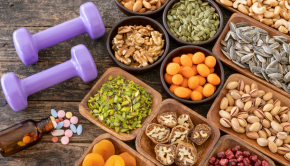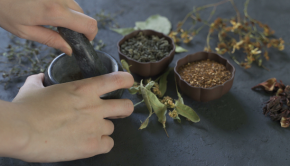Six Ways to Eat Safe
The Latest Facts about Organics, Pesticides, Seeds and More
Hot fun in the summertime begins with fresh, sweet and savory seasonal flavors brought to life in al fresco gatherings with family and friends. As the popularity of farmers’ markets and home gardening surges onward, it’s time to feast on the tastiest produce, picked ripe from America’s farms and gardens for peak flavor and nutrition.
Similar to raising a sun umbrella, learning where food comes from and how it’s produced provides the best protection against getting burned. Here’s the latest on some of the season’s hottest food issues to help families stay safe and well nourished.
Local Organic Reigns Supreme
Diana Dyer, a registered dietitian and garlic farmer near Ann Arbor, Michigan, observes, “You can’t buy happiness, but you can buy local, and that’s kind of the same thing.” Purchasing local foods whenever possible has many merits, including shaking the farmer’s hand, asking about farming methods and developing sincere relationships. Buying local also supports the local economy and contributes to food security.
Yet “local” alone does not necessarily mean better. Even small farmers may use harmful pesticides or feed their livestock genetically modified or engineered (GM, GMO or GE) feed. That’s one reason why the smartest food choice is organic, with local organic being the gold standard.
The U.S. Department of Agriculture (USDA) organic certification label ensures that strict national organic standards—prohibiting the use of antibiotics, hormones and GM feed and ingredients—have been met. Plus, organically raised livestock must have access to the outdoors and ample time on pastures, naturally resulting in milk and meat with higher levels of health-protecting omega-3 fatty acids.
Still, organic naysayers abound. For example, many negative headlines were generated by a recent Stanford University study that questioned whether or not organic foods are safer or more healthful than conventional. Few news outlets relayed the researchers’ actual conclusions—that organic foods may reduce exposure to pesticide residues and antibiotic-resistant bacteria; children on organic diets have significantly lower levels of pesticide metabolites, or breakdown products, in their urine; organic milk may contain significantly higher levels of omega-3 fatty acids; and organic produce contains higher levels of health-protecting antioxidants.
Jim Riddle, former organic outreach coordinator at the University of Minnesota, in Lamberton, explains that organic farming methods are based on building and improving the soil, promoting biodiversity and protecting natural resources, regardless of the size of the farm. Healthier ecosystems, higher quality soil and clean water will produce healthier plants, which in turn support healthier animals and humans on a healthier planet.
Pesticide Problems and Solutions
Children are most vulnerable to the effects of pesticides and other environmental toxins, due to their smaller size and rapid physical development. Last December, the American Academy of Pediatrics issued a policy statement that asserted, “Beyond acute poisoning, the influences of low-level pesticide exposures on child health are of increasing concern.” The organization links pesticide exposure to higher risk for brain tumors, leukemia, attention deficit disorders, autism and reductions in IQ.
Because weeds naturally develop resistance to the herbicides designed to kill them, Dow AgroSciences has genetically engineered seeds to produce crops that can withstand spraying with both the systemic herbicide glyphosate (Roundup), and 2,4-D, one of the active ingredients in Agent Orange, used as a defoliant in the Vietnam War. The latter is commonly applied to lawns and wheat-producing agricultural land, even though research reported in the journal Environmental Health Perspectives links exposure to 2,4-D to birth defects and increased cancer risk. Dow AgroSciences’ new GE seeds await regulatory approval.
Eric Mader, program director at the Portland, Oregon-based Xerces Society for the conservation of invertebrates and pollinator protection, warns that broad-spectrum pesticides kill beneficial insects along with those considered pests. Mader recommends increasing the number of beneficial insects, which feed on pests, by planting a greater diversity of native plants on farms and in home gardens.
Demand for GMO Labeling
Despite California’s narrow defeat of Proposition 37, which would have required statewide labeling of products containing GMOs, advocates at the Environmental Working Group and the Just Label It campaign are pushing the U.S. Food and Drug Administration (FDA) for nationwide GMO labeling. Responding to consumer demand, Whole Foods Market recently announced that it will require GMO labeling in all of its U.S. and Canadian stores by 2018.
Filmmaker Jeremy Seifert’s powerful new documentary, GMO OMG, should give the movement a major push, as well. The 2013 film explores the danger in corporate patenting of seeds and the unknown health and environmental risks of engineered food. Seifert says, “I have a responsibility to my children to hand on to them a world that is not poisoned irreparably.” As for the promise that GMOs are required to “feed the world,” he believes it’s a lie, noting that it’s better to “feed the world well.”
Seed Freedom and Food Choice
Roger Doiron, founder and director of Kitchen Gardeners International, headquartered in Scarborough, Maine, celebrates Food Independence Day each July Fourth. Doiron believes that growing, harvesting, cooking and preserving food is both liberating and rewarding, and patriotic. More than 25,000 individuals from 100 countries belong to his nonprofit network that focuses on re-localizing the world’s food supply. Food freedom starts with seeds.
Saving and trading heirloom, non-hybrid, non-GMO seeds is becoming as easy as checking out a library book. Several libraries across the country are serving as seed banks, where patrons check out seeds, grow crops, save seeds and then donate some back to their local library.
Liana Hoodes, director of the National Organic Coalition, in Pine Bush, New York, is a fan of her local Hudson Valley Seed Library. The library adheres to Indian Physicist Vandana Shiva’s Declaration of Seed Freedom and makes sure all seed sources are not related to, owned by or affiliated with biotech or pharmaceutical corporations. In addition to preserving heirloom and open-pollinated varieties, each seed packet is designed by a local artist.
Get Your Non-GMOs Here
Reading labels is always a good practice. We can also rely on trusted sources to help us sort out suspect products from the natural whole foods that we know are good for us. Here’s a short list of websites and associated apps to help make food shopping a bit easier.
- CenterForFoodSafety.org; Tinyurl.com/getCenterForFoodSafetyapp
- Fooducate.com; Tinyurl.com/getFooducateGMOapp
- NonGMOProject.org; Tinyurl.com/getNonGMOProjectapp
- NonGMOShoppingGuide.com; Tinyurl.com/getShopNoGMOapp
- Also take action at Buycott.com: Tinyurl.com/getBuycottGMOapp
Finicky about Fish
Grilled fish makes a lean, heart-healthy, low-calorie summer meal. Some fish, however, may contain chemicals that pose health risks, especially for pregnant or nursing women and children. For example, according to the U.S. Environmental Protection Agency (EPA), nearly all fish and shellfish contain traces of mercury, which is toxic to a baby’s developing nervous system. Both the EPA and local state health departments post consumption advisories that recommend limiting or avoiding certain species of fish caught in specific locations.
For several decades, Captain Anne Mosness, a wild salmon fisherwoman, operated commercial fishing boats in Washington waters and from Copper River to Bristol Bay, Alaska. She worries about the threat of pollution from industrial aquaculture, plus the effects of genetically engineered salmon on wild fish populations, coastal economies and ecosystems.
Mosness explains that AquAdvantage Salmon, a product of AquaBounty Technologies, was created “by inserting a growth hormone gene from Pacific Chinook and a promoter gene from an eel-like fish called ocean pout into Atlantic salmon.” She questions the FDA approval process and failure to address unanswered questions about the risks of introducing “novel” animals into the food supply, as well as related food allergies and greater use of antibiotics in weaker fish populations. “The salmon farming industry already uses more antibiotics per weight than any other animal production,” comments Mosness.
The FDA’s official public comment period on GMO salmon closed in April, but consumers can still voice concerns to their legislators while demanding and applauding national GMO labeling. GMO fish may be on our dinner plates by the end of the year, but with labels, consumers gain the freedom to make informed choices. Consumers can also ask retailers not to sell GMO fish. Trader Joe’s, Aldi and Whole Foods have all committed to not selling GMO seafood.
Antibiotic Resistance
According to the Centers for Disease Control and Prevention, antibiotics are one of the greatest public health achievements of the past 100 years. However, one of the most critical public health and economic issues we currently face is the loss of these drugs’ effectiveness, due in large part to their misuse and overuse in industrial agriculture.
Dr. David Wallinga, senior advisor in science, food and health at the Institute of Agriculture and Trade Policy, says that about 80 percent of all antibiotics are given to farm animals for two reasons: to prevent illness associated with living in crowded, stressful and often unsanitary conditions; and to promote “feed efficiency”, or weight gain. However, bacteria naturally mutate to develop resistance to antibiotics when exposed to doses that are insufficient to kill them.
Wallinga points out that antibiotic-resistant infections, such as methicillin-resistant Staphylococcus aureus (MRSA), cost our nation at least $20 billion annually and steal tens of thousands of American lives each year. Most recently, hard-to-treat urinary tract infections (UTI), were traced to antibiotic-resistant E. coli bacteria in chickens.
Antibiotic-resistant bacteria exist in our environment, but are more likely to be found in conventionally, rather than organically raised meat and poultry, which by law must be raised without antibiotics. Consumers beware: the word “natural” on food labels does not provide the same protection. The good news is that according to Consumers Union research, raising meat and poultry without antibiotics can be accomplished at minimal cost to the consumer—about five cents extra per pound for pork and less than a penny per pound extra for chicken.
Food Supply News Sources
Antibiotic Resistance
- Healthy Food Action: HealthyFoodAction.org
- Institute for Agriculture and Trade Policy: iatp.org
- Keep Antibiotics Working: KeepAntibioticsWorking.com
- Meat Without Drugs: MeatWithoutDrugs.org
- Not in My Food: Tinyurl.com/NotInMyFoodNoAntibiotics
Fish Food Safety
- Center for Food Safety: CenterForFoodSafety.org
- Food and Water Watch: FoodAndWaterWatch.org
- Food Sleuth Radio interview with fisherwoman, Anne Mosness: Tinyurl.com/FoodSleuthRadioAnneMosness
GMOs
- GMO Food Labeling: JustLabelIt.org
- GMO OMG: GMOFilm.com
Local/Organic
- Eat Local: Simple Steps to Enjoy Real, Healthy and Affordable Food, by Jasia Steinmetz: TableOfTheEarth.com/eat-local-simple-steps
- Organic Farming Research Foundation: ofrf.org
Pesticides
- Safe Lawns: SafeLawns.org
- Xerces Society: Xerces.org/mission
Seed Freedom and Food Choice
- Kitchen Gardeners International: kgi.org
- National Center for Home Food Preservation: nchfp.uga.edu
- Seed Libraries: NewDream.org and Tinyurl.com/StartLocalSeedLibrary
- Seed Matters: Tinyurl.com/SeedMattersCommunityProject





























